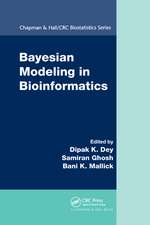Statistical Analysis of Contingency Tables
Autor Morten Fagerland, Stian Lydersen, Petter Laakeen Limba Engleză Paperback – 25 feb 2020
For more information, including a sample chapter and software, please visit the authors' website.
| Toate formatele și edițiile | Preț | Express |
|---|---|---|
| Paperback (1) | 395.13 lei 3-5 săpt. | +37.67 lei 4-10 zile |
| CRC Press – 25 feb 2020 | 395.13 lei 3-5 săpt. | +37.67 lei 4-10 zile |
| Hardback (1) | 564.56 lei 6-8 săpt. | |
| CRC Press – 12 iul 2017 | 564.56 lei 6-8 săpt. |
Preț: 395.13 lei
Preț vechi: 429.48 lei
-8% Nou
Puncte Express: 593
Preț estimativ în valută:
75.62€ • 78.50$ • 63.05£
75.62€ • 78.50$ • 63.05£
Carte disponibilă
Livrare economică 04-18 martie
Livrare express 15-21 februarie pentru 47.66 lei
Preluare comenzi: 021 569.72.76
Specificații
ISBN-13: 9780367495268
ISBN-10: 0367495260
Pagini: 656
Ilustrații: 163 Tables, black and white; 180 Line drawings, black and white; 180 Illustrations, black and white
Dimensiuni: 156 x 234 x 40 mm
Greutate: 0.93 kg
Ediția:1
Editura: CRC Press
Colecția Chapman and Hall/CRC
ISBN-10: 0367495260
Pagini: 656
Ilustrații: 163 Tables, black and white; 180 Line drawings, black and white; 180 Illustrations, black and white
Dimensiuni: 156 x 234 x 40 mm
Greutate: 0.93 kg
Ediția:1
Editura: CRC Press
Colecția Chapman and Hall/CRC
Cuprins
Introduction
The 1 × 2 Table and the Binomial Distribution
The 1 × c Table and the Multinomial Distribution
The 2 × 2 Table
The Ordered r × 2 Table
The Ordered 2 × c Table
The r × c Table
The Paired 2 × 2 Table
The Paired c × c Table
Stratified 2 × 2 Tables and Meta-Analysis
Other Stratified Tables
Sample Size Calculations
Miscellaneous Topics
The 1 × 2 Table and the Binomial Distribution
The 1 × c Table and the Multinomial Distribution
The 2 × 2 Table
The Ordered r × 2 Table
The Ordered 2 × c Table
The r × c Table
The Paired 2 × 2 Table
The Paired c × c Table
Stratified 2 × 2 Tables and Meta-Analysis
Other Stratified Tables
Sample Size Calculations
Miscellaneous Topics
Recenzii
"The contingency table is one of the simplest and best explored methods for summarising and analysing. This extensive book covers all areas of contingency table analysis. The initial chapters describe in depth, and with examples, one particular type of table, characterized by size (the number of rows and the number of columns), whether the variables are ordinal or nominal, whether the tables are stratified or not, and whether the observations are paired or unpaired. Other chapters consider meta-analysis, sample size issues, and inter-rater agreement studies. The style of the book reflects the simplicity of the subject. Each topic is considered on its own merit, and the latest research in this topic is discussed and illustrated. The mathematics is easily accessible. This book is encyclopaedic in its coverage and would be useful to graduate students and all applied statisticians who are always dealing with contingency tables."
—Professor MJ Campbell, Emeritus Professor of Medical Statistics School of Health and Related Research, University of Sheffield
"This encyclopaedic book deals comprehensively with statistical methods for data arranged as one and two dimensional contingency tables and stratified data. The detailed evaluation of the performance of various competing methods heeds recently developed as well as more traditional criteria. Numerous practical examples are given, mainly from the healthcare domain, alongside Matlab and R code for all the methods recommended. I strongly recommend the book both to statisticians and to researchers in health and social disciplines."
—Robert G. Newcombe, Emeritus Professor, Cardiff University, Author of Confidence Intervals for Proportions and Related Measures of Effect Size
"This 600+ page book comprehensively covers the analysis of one-, two- and three-dimensional (stratified) contingency tables. Such low-dimensional tables are the types of contingency tables that most researchers encounter in real life. The book is primarily for practitioners at Master’s and/or PhD level. This book is highly recommended because it covers over 250 analytic methods, includes up-to-date material typically only found in specialist journals, evaluates alternative analytic methods, makes recommendations for their practical use, and illustrates the use of the methods on real life data. A companion website provides Matlab- and R-code for almost all the methods described. The book is unique because it is so comprehensive and up-to-date, its chapters are to a large extent self-contained so that the analyst will find all they need to know in the relevant chapter without having to read the preceding chapters, and the recommendations make the book more practically useful than other texts. In summary, an essential book to own if you analyse low-dimensional contingency tables."
—John McDonald, Professor of Social Statistics (retired), University of Southampton
"The authors provide an in-depth survey of the overwhelmingly large number of methods that are now available for conducting statistical inference with contingency tables. What sets this book apart from others is its detailed performance evaluations of the confidence interval and significance testing methods, followed by recommendations about what to use for various purposes. This book should be a very useful reference for anyone who wants an overview of the relevant literature (much of it quite recent) or who routinely needs to analyze contingency tables."
—Alan Agresti, Distinguished Professor Emeritus, University of Florida
"This statistical text on the analysis of contingency tables has three outstanding features. It is comprehensive without being unwieldy; it maintains an ideal balance between theory and application; and it is consistently systematic. For each type of contingency table structure it deals with, it covers a variety of analytic methods, assesses the properties of each method and gives appropriate recommendations. Further, each section has a relevant, illuminative practical example. I highly recommended it for masters and doctoral students in statistics, biostatistics and epidemiology, instructors and researchers in those fields as well as applied researchers in the social sciences, psychology, public health, medicine and other fields requiring the analysis of discrete data."
—Karim F Hirji, Fellow, Tanzania Academy of Sciences, Author of Exact Analysis of Discrete Data
"...Not only researchers, but also PhD students of modern and applied medicine, should express our thanks to the authors for providing this book, which is an immensely valuable tool. …The chapters are arranged according to the order of the table (number of rows and number of columns), so that one can refer exactly to the needed topic without the requirement to read preceding chapters. The authors have organized every chapter in very logical manner with supportive tables and/or diagrams and graphs. …The book has been enriched by the inclusion of features such as recommendations and practical applications. The book covers many topics, even meta-analysis and stratified tables. The authors explain the theory and practical solution of the relevant example clearly. The addition of chapter wise lists of statistical methods and examples as an appendix makes this book even easier for the reader to navigate. The authors refer to the relevant literature extensively, making the book meticulous. Any person who wants to do a research analysis using contingency tables can refer to this book, as the authors succeed in explaining all of the concepts with least possible mathematical calculations. … I congratulate the authors for publishing such an excellent book."
-Alka Dilip Gore, ISCB June 2018
—Professor MJ Campbell, Emeritus Professor of Medical Statistics School of Health and Related Research, University of Sheffield
"This encyclopaedic book deals comprehensively with statistical methods for data arranged as one and two dimensional contingency tables and stratified data. The detailed evaluation of the performance of various competing methods heeds recently developed as well as more traditional criteria. Numerous practical examples are given, mainly from the healthcare domain, alongside Matlab and R code for all the methods recommended. I strongly recommend the book both to statisticians and to researchers in health and social disciplines."
—Robert G. Newcombe, Emeritus Professor, Cardiff University, Author of Confidence Intervals for Proportions and Related Measures of Effect Size
"This 600+ page book comprehensively covers the analysis of one-, two- and three-dimensional (stratified) contingency tables. Such low-dimensional tables are the types of contingency tables that most researchers encounter in real life. The book is primarily for practitioners at Master’s and/or PhD level. This book is highly recommended because it covers over 250 analytic methods, includes up-to-date material typically only found in specialist journals, evaluates alternative analytic methods, makes recommendations for their practical use, and illustrates the use of the methods on real life data. A companion website provides Matlab- and R-code for almost all the methods described. The book is unique because it is so comprehensive and up-to-date, its chapters are to a large extent self-contained so that the analyst will find all they need to know in the relevant chapter without having to read the preceding chapters, and the recommendations make the book more practically useful than other texts. In summary, an essential book to own if you analyse low-dimensional contingency tables."
—John McDonald, Professor of Social Statistics (retired), University of Southampton
"The authors provide an in-depth survey of the overwhelmingly large number of methods that are now available for conducting statistical inference with contingency tables. What sets this book apart from others is its detailed performance evaluations of the confidence interval and significance testing methods, followed by recommendations about what to use for various purposes. This book should be a very useful reference for anyone who wants an overview of the relevant literature (much of it quite recent) or who routinely needs to analyze contingency tables."
—Alan Agresti, Distinguished Professor Emeritus, University of Florida
"This statistical text on the analysis of contingency tables has three outstanding features. It is comprehensive without being unwieldy; it maintains an ideal balance between theory and application; and it is consistently systematic. For each type of contingency table structure it deals with, it covers a variety of analytic methods, assesses the properties of each method and gives appropriate recommendations. Further, each section has a relevant, illuminative practical example. I highly recommended it for masters and doctoral students in statistics, biostatistics and epidemiology, instructors and researchers in those fields as well as applied researchers in the social sciences, psychology, public health, medicine and other fields requiring the analysis of discrete data."
—Karim F Hirji, Fellow, Tanzania Academy of Sciences, Author of Exact Analysis of Discrete Data
"...Not only researchers, but also PhD students of modern and applied medicine, should express our thanks to the authors for providing this book, which is an immensely valuable tool. …The chapters are arranged according to the order of the table (number of rows and number of columns), so that one can refer exactly to the needed topic without the requirement to read preceding chapters. The authors have organized every chapter in very logical manner with supportive tables and/or diagrams and graphs. …The book has been enriched by the inclusion of features such as recommendations and practical applications. The book covers many topics, even meta-analysis and stratified tables. The authors explain the theory and practical solution of the relevant example clearly. The addition of chapter wise lists of statistical methods and examples as an appendix makes this book even easier for the reader to navigate. The authors refer to the relevant literature extensively, making the book meticulous. Any person who wants to do a research analysis using contingency tables can refer to this book, as the authors succeed in explaining all of the concepts with least possible mathematical calculations. … I congratulate the authors for publishing such an excellent book."
-Alka Dilip Gore, ISCB June 2018
Descriere
This book is an invaluable tool for statistical inference in contingency tables. It covers effect size estimation, confidence intervals, and hypothesis tests for the binomial and the multinomial distributions, unpaired and paired 2x2 tables, rxc tables, ordered rx2 and 2xc tables, paired cxc tables, and stratified tables.












